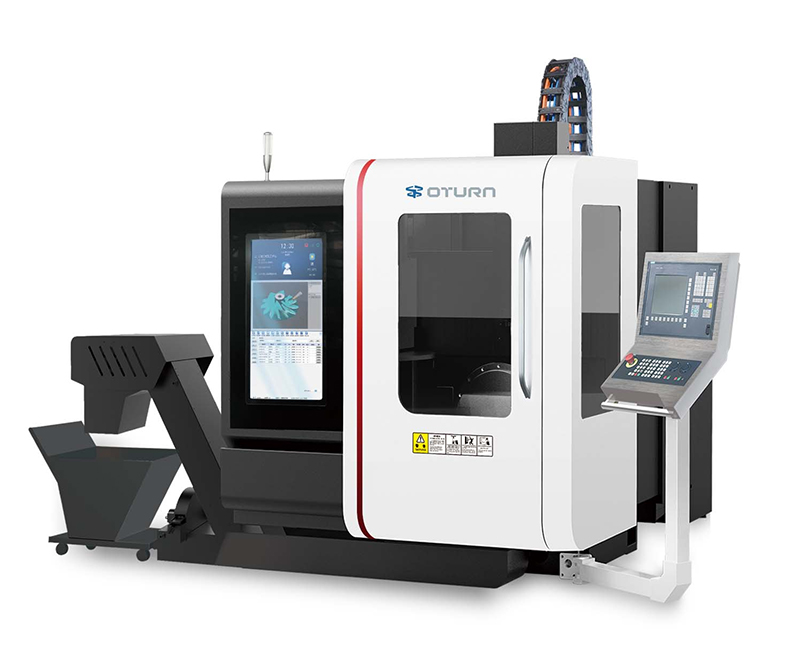5-axis vertical machining center have become key equipment in high-end manufacturing due to their ability to achieve high-precision machining of complex components. Their machining accuracy not only determines product quality but also represents the core of the equipment’s competitiveness. Achieving this high-precision machining relies on the coordinated efforts of multiple aspects, including the mechanical structure, CNC system, and detection and compensation, forming a systematic and comprehensive precision assurance system. The following detailed analysis of each key link will help you understand its underlying logic and advanced technologies.
I. Mechanical Structural Rigidity Design: The Solid Foundation of Precision
The rigidity of the mechanical structure directly determines the equipment’s stability and deformation resistance during machining. In a 5-axis VMC, the bed and column serve as the “framework” of the entire machine. They are typically constructed of high-strength cast iron or granite. Aging treatment effectively eliminates internal stresses and significantly reduces deformation caused by cutting loads. The guideway and lead screw drive components are key to ensuring linear motion accuracy, requiring strict control of all-dimensional precision. Rolling guides utilize preload to eliminate backlash and enhance positioning rigidity. Ball screws utilize a double-nut preload structure to effectively eliminate backlash and minimize transmission errors. The support system for rotating axes (such as the A-axis and C-axis) is crucial. High-precision crossed roller bearings and worm gears are employed to withstand radial and axial loads while maintaining rotational clearance within an angular range of several seconds to tens of seconds, significantly improving angular positioning accuracy. The spindle unit is supported by precision ceramic bearings or aerostatic bearings. Dynamic balancing ensures that radial runout and axial play are controlled to the micron level during high-speed rotation, preventing vibration from becoming a source of machining error.
II. Precision Control of the CNC System—The “Brain” of Precision
The accuracy of five-axis machining depends not only on mechanical rigidity but also on the precise control of motion by the CNC system. The system calculates the trajectory and speed of each axis in real-time and, through interpolation algorithms, generates a continuous and smooth motion path, ensuring that the tool trajectory meets design requirements. Feedforward control technology predicts the trajectory and adjusts the servo motor output in advance, significantly reducing following error.
The position feedback system uses a high-resolution scale or encoder to collect actual axis position data in real-time. Combined with a PID closed-loop control algorithm, it rapidly corrects positioning deviations, maintaining positioning error within micron levels. In five-axis machining, the CNC system uses a kinematic model to precisely transform coordinates for the complex motion relationships between rotary and linear axes and achieves precise tool positioning accuracy at any point in space, ensuring high-precision performance in five-axis machining.
III. Detection and Compensation Mechanisms: The Guardians of Dynamic Precision
Accurate measurement and timely compensation are key to maintaining long-term equipment accuracy. Before shipment, the equipment must undergo comprehensive testing of positioning error, repeatability error, and backlash on each axis using high-precision instruments such as laser interferometers and ballbars. This ensures that all mechanical errors are digitally recorded and corrected through CNC system parameter compensation.
Thermal expansion and mechanical deformation caused by temperature fluctuations are significant accuracy hazards during long-term machining. Temperature sensors monitor the equipment’s ambient temperature and the temperature rise of the spindle and guideways in real time. Dynamic compensation strategies, combined with established thermal error models, significantly minimize the impact of temperature interference on machining accuracy.
Regular calibration is also essential for maintaining accuracy. Through comparisons with standard parts and multi-point verification using precision inspection tools, precision deviations caused by mechanical wear or loose components can be promptly detected, allowing equipment parameters to be adjusted and corrected to ensure long-term stable machining performance.
IV. Systematic Precision Control—From Static High Precision to Dynamic Stability
The precision assurance of a 5-axis vertical machining center is the result of the complementary and coordinated cooperation of various components. The mechanical structure provides a rigid foundation, the CNC system enables precise motion control, and a comprehensive detection and compensation mechanism ensures dynamic precision.
This systematic precision control system not only ensures pristine mechanical accuracy when the equipment is static, but also effectively resists various interference factors such as vibration, thermal deformation, and load fluctuations in complex machining environments, achieving the high-precision machining requirements for complex parts.
With the continuous advancement of intelligent manufacturing technology, adaptive compensation technologies combining artificial intelligence and big data analysis have gradually been put into use, introducing breakthroughs in the precision assurance of 5-axis machining center, further enhancing their manufacturing capabilities and market competitiveness.
In summary, the high precision of 5-axis vertical machining centers is not a result of chance, but the result of the highly integrated and meticulous collaboration of three pillars: mechanical design, control algorithms, and detection and compensation. Only by scientifically constructing and continuously optimizing this precision assurance system can we meet the stringent precision requirements of high-end manufacturing for complex parts and advance intelligent manufacturing to a higher level.
For more information, visit us at EMO, Hall 15, Booth B54, September 22-27, 2025. We’ll showcase the latest 5-axis machining technologies, experience turning-edge equipment, and engage in in-depth discussions with industry experts. We sincerely invite you to discuss the future of intelligent manufacturing and unlock a new chapter in high-precision machining!
Post time: Aug-27-2025








